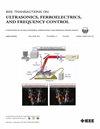Wideband Surface Acoustic Wave Resonator With Good Temperature Stability Using LiNbO3 on Glass
IF 3.7
2区 工程技术
Q1 ACOUSTICS
IEEE transactions on ultrasonics, ferroelectrics, and frequency control
Pub Date : 2025-03-10
DOI:10.1109/TUFFC.2025.3548977
引用次数: 0
Abstract
Currently, wideband surface acoustic wave (SAW) devices are in demand. However, SAW resonators with a large coupling factor have a large negative temperature coefficient of frequency (TCF). In this work, we developed a new hetero acoustic layer (HAL) structure combining LiNbO3 (LN) and a glass with a low coefficient of thermal expansion (CTE), called ABC-G glass, to obtain the resonator with both large bandwidth (BW) and low TCF. The bulk and leaky SAW (LSAW) velocities of ABC-G glass were measured by ultrasonic microspectroscopy (UMS) technology, and its positive temperature coefficient of velocity (TCV) was confirmed. The (0°, 101°, 0°) and (0°, 120°, 0°) LNs are selected for experiments. The measured results show impedance ratio (Z-ratio) and BW as high as 82 dB and 12%, respectively. The measured TCFs reach −27 ppm/°C and −24 ppm/°C at resonance and antiresonance frequency, respectively, which are significantly improved compared with LN/Quartz (Qz). Ladder filters composed of three LN/ABC-G resonators are prototyped using a T-type configuration, and the insertion loss lower than 1 dB with a fractional bandwidth (FBW) of 15.0% was demonstrated. At the same time, no spurious response was observed up to 10 GHz. The results shown in this work prove the high performance of the LN/ABC-G structure in applications requiring good temperature stability, large BW, and out-of-band spurious-free characteristics.基于玻璃表面LiNbO3的温度稳定性良好的宽带表面声波谐振器。
目前,对宽带表面声波(SAW)器件的需求越来越大。然而,耦合系数较大的声表面波谐振器具有较大的负频率温度系数。在这项工作中,我们开发了一种新的杂声层(HAL)结构,将LiNbO3 (LN)与低热膨胀系数(CTE)玻璃(ABC-G玻璃)结合在一起,获得了大带宽(BW)和低TCF的谐振器。采用超声显微光谱(UMS)技术测定了ABC-G玻璃的体速和漏速,确定了其正温度速度系数(TCV)。选择(0°,101°,0°)和(0°,120°,0°)LNs进行实验。测量结果表明,阻抗比(Z-ratio)和BW分别高达82 dB和12%。在谐振频率和反谐振频率下,tcf分别达到-27 ppm/°C和-24 ppm/°C,与LN/ Quartz (Qz)相比有显著提高。采用t型结构设计了由3个LN/ ABC-G谐振腔组成的梯形滤波器,其插入损耗小于1 dB,分数带宽(FBW)为15.0%。同时,在10ghz以内未观察到杂散响应。本工作的结果证明了LN/ ABC-G结构在需要良好温度稳定性、大体宽和无带外杂散特性的应用中的高性能。
本文章由计算机程序翻译,如有差异,请以英文原文为准。
求助全文
约1分钟内获得全文
求助全文
来源期刊
CiteScore
7.70
自引率
16.70%
发文量
583
审稿时长
4.5 months
期刊介绍:
IEEE Transactions on Ultrasonics, Ferroelectrics and Frequency Control includes the theory, technology, materials, and applications relating to: (1) the generation, transmission, and detection of ultrasonic waves and related phenomena; (2) medical ultrasound, including hyperthermia, bioeffects, tissue characterization and imaging; (3) ferroelectric, piezoelectric, and piezomagnetic materials, including crystals, polycrystalline solids, films, polymers, and composites; (4) frequency control, timing and time distribution, including crystal oscillators and other means of classical frequency control, and atomic, molecular and laser frequency control standards. Areas of interest range from fundamental studies to the design and/or applications of devices and systems.

 求助内容:
求助内容: 应助结果提醒方式:
应助结果提醒方式:


